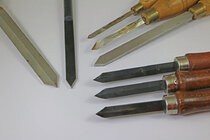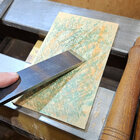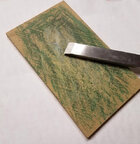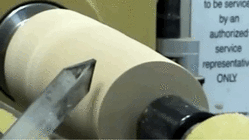Anyone relieve the heel to save time when touching up the cutting edge of a diamond parting tool?
-
December 2025 Turning Challenge: Single Tree! (click here for details) -
Congratulations to Bob Henrickson, People's Choice in the November 2025 Turning Challenge (click here for details) -
Congratulations to Steven Gordon for "Dropped Ice Cream Cone" being selected as Turning of the Week for December 8, 2025 (click here for details) -
Welcome new registering member. Your username must be your real First and Last name (for example: John Doe). "Screen names" and "handles" are not allowed and your registration will be deleted if you don't use your real name. Also, do not use all caps nor all lower case.
You are using an out of date browser. It may not display this or other websites correctly.
You should upgrade or use an alternative browser.
You should upgrade or use an alternative browser.
Relieve Diamond Part Tool Heel?
- Thread starter Don Stephan
- Start date
john lucas
AAW Forum Expert
Never have removed the heel of my parting tools even though I do on all others. The heel of the parting tool.never touches anything.
- Joined
- Apr 27, 2004
- Messages
- 9,304
- Likes
- 6,058
- Location
- Lakeland, Florida
- Website
- www.hockenberywoodturning.com
A diamond parting tool's best purpose is as a tent stake. Unless that cutting edge is maintained dead-on at that rib, it's a less-than stellar cutting tool.
I don't recommend them, if asked. I suggest only uniform thickness parting tools. To those who say the diamond shape doesn't get as caught up in the groove being cut, I suggest that regardless of the tool, you should be making your cut a hair wider than the tool anyway to avoid friction and binding.
Whoever invented the diamond gave us a poor solution to a problem that never existed.
I don't recommend them, if asked. I suggest only uniform thickness parting tools. To those who say the diamond shape doesn't get as caught up in the groove being cut, I suggest that regardless of the tool, you should be making your cut a hair wider than the tool anyway to avoid friction and binding.
Whoever invented the diamond gave us a poor solution to a problem that never existed.
Watching a demo by Art Leistman last night, I was reminded of his sharpening a 1/8" parting tool on its side on the platform (platform at 90 degrees to the wheel. This puts the concave hollow grind along the width of the tool's edge and allows the tool to track straight into the wood without 'seeking' the intended line. The long ground edge also can be used at an angle to shear-scrape a small raised surface.
I had seen him do this at a past demo a few years ago and it works well when I tried it...
I had seen him do this at a past demo a few years ago and it works well when I tried it...
Anchor bevel cut is great way to bring cutting edge to oncoming wood. But in my opinioin relieving heel of parting tool will have no effet on a-b-c.I don’t
Easier to sharpen.
The concave bevel makes it easier to line up on my line to make the cut
The ABC works with the parting tool
Anchor, Bevel, Cut
View attachment 66881
"relieve the heel to save time when touching up the cutting edge"
I guess I've never felt the need to save time when sharping a parting tool. Set the platform angle, grind a couple of seconds on a 600 grit CBN, hone off any detectable burr by touching too a leather wheel, done.
FWIW, I've taken to a different grind on some of my "diamond" parting tools, a different angle on the "top" with the point meeting the widest part of the diamond cross section.
The three at the bottom show this grind.

These are the old Craftsman parting tools - the ones I use the most for general work.
I like the angle which allows entry into the wood at a slightly different tool/handle presentation which feels comfortable too me.
I find this a little easier to make a very clean cut.
It does make these tools usable with just one side up which hasn't been a problem.
The other one I use the most is the Thompson, the vertical one in this picture. The shaft on this is 5" long, about 1/2" diameter - I hold the shaft, have never put it in a handle.
I use this, and some others with flat sides, but twisting it back and forth very slightly when making a deep sizing cut. This lets the sharp edges behind the point shave away a tiny bit of wood on both sides to increase the clearance.
I've ground the sides flat on one of the smallest tool to make the cut thinner - handy in some situations.
JKJ
I guess I've never felt the need to save time when sharping a parting tool. Set the platform angle, grind a couple of seconds on a 600 grit CBN, hone off any detectable burr by touching too a leather wheel, done.
FWIW, I've taken to a different grind on some of my "diamond" parting tools, a different angle on the "top" with the point meeting the widest part of the diamond cross section.
The three at the bottom show this grind.

These are the old Craftsman parting tools - the ones I use the most for general work.
I like the angle which allows entry into the wood at a slightly different tool/handle presentation which feels comfortable too me.
I find this a little easier to make a very clean cut.
It does make these tools usable with just one side up which hasn't been a problem.
The other one I use the most is the Thompson, the vertical one in this picture. The shaft on this is 5" long, about 1/2" diameter - I hold the shaft, have never put it in a handle.
I use this, and some others with flat sides, but twisting it back and forth very slightly when making a deep sizing cut. This lets the sharp edges behind the point shave away a tiny bit of wood on both sides to increase the clearance.
I've ground the sides flat on one of the smallest tool to make the cut thinner - handy in some situations.
JKJ
Last edited:
- Joined
- Apr 27, 2004
- Messages
- 9,304
- Likes
- 6,058
- Location
- Lakeland, Florida
- Website
- www.hockenberywoodturning.com
That would seem to be a benefit as it will work better burr updoes make these tools usable with just one side up which hasn't been a problem.
Easy to remember which is up
The convex bevel makes the bevel angle steeper too. + & - on the steeper angle.
Last edited:
john lucas
AAW Forum Expert
I used to grind my diamond parting tool with a much more pronounced cove top. Don't know why I quit doing that.
That would seem to be a benefit as it will work better burr up
I don't know about that. After sharpening any tool I always remove the grinder burr with a strop.
I usually use one of three types of strops:
- A leather strop, sometimes thin leather glued to a flat board
- The leather wheel on the Tormek with honing paste applied
- Better for straight cutting edges like parting tools and skews is a hard strop
Some of the "hard" strop boards, mostly for skews but I use them on parting and other tools:


JKJ
Last edited:

